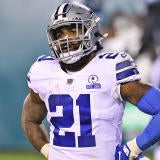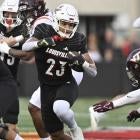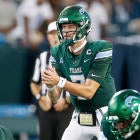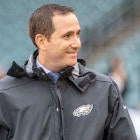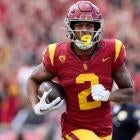Free agency begins March 9 when the 2017 league year starts. This gives NFL teams a little more than two weeks to get their books in optimal shape for the league’s annual signing frenzy.
Contract restructurings, pay cuts and player cuts take center stage during the earliest part of the offseason. A contract restructuring is different from a pay cut. In a typical restructuring, a player will convert some portion of his base salary or roster bonus (without reducing salary) into signing bonus because it can be prorated or spread out evenly over the life of a contract (most other salary components usually can’t be prorated) for a maximum of five years. The team gets a lower cap number in the current season while the player gains more short-term security.
When a player is released or traded, the remaining proration of the salary components that are treated like signing bonus immediately accelerate into his team’s current salary cap. There are two major exceptions to this general rule of bonus proration accelerating. Only the current year’s proration counts toward the cap with players released or traded after June 1. The bonus proration in future contract years is delayed until the following season.
A team can also release two players each year prior to June 1 (known as a post-June 1 designation) that will be treated under the cap as if they were released after June 1. With a post-June 1 designation, a team is required to carry the player’s full cap number until June 2 even though he is no longer a part of the roster. The player’s salary comes off the books at that time unless it is guaranteed.
NFL teams were informed at a December league meeting that the 2017 salary cap is preliminarily projected to be between $166 million and $170 million. The 2017 salary cap will be finalized before the end of the month or early March. It has been set at the high end of projections or slightly over in recent years.
Below is a look at the three teams with the worst salary cap situations heading into the free agency assuming a $168 million salary cap. All teams must be must become compliant with the salary cap when the new league year begins. In the offseason, only the top 51 cap numbers count on the cap. Tenders for restricted free agents and exclusive rights players with expiring contracts, which mostly haven’t been made yet, and adjustments for earned incentives have been included in each team’s calculations in order to give a more complete cap picture.
1. New York Jets
Projected salary cap overage: $2.76 Million
Team needs: QB, LT, CB, Edge rusher
Key unrestricted free agents: OT Ryan Clady, QB Ryan Fitzpatrick, TE Kellen Davis, OT Ben Ijalana
Potential restricted free agent tenders: TE Brandon Bostick, C Wesley Johnson, CB Marcus Williams, all at $1.808 million
A disappointing 5-11 season in 2016 has created a sense urgency for coach Todd Bowles and general manager Mike Maccagnan. Since surviving another season like 2016 will be difficult for the duo, expect a lot of work to be done to the roster. It’s already begun with $10 million of cap space picked up by declining the option on Ryan Clady’s 2017 contract.
Next season’s starting quarterback probably wasn’t with the team in 2016. Ryan Fitzpatrick isn’t expected back after a lackluster season in which he was benched and only regained his starting job after a season-ending knee injury to Geno Smith, who is also a free agent. 2015 fourth-round pick Bryce Petty didn’t make a good case for being the quarterback of the future when given the opportunity to play. 2016 second-round pick Christian Hackenberg is a project. He was inactive for every game except the season finale, in which he did not play.
There may be plenty of experienced veteran quarterbacks available as free agents, through trade or by release. These could include Jay Cutler, Colin Kaepernick, Tony Romo and Tyrod Taylor. An intriguing younger option may be Mike Glennon, who has barely played since the Buccaneers took Jameis Winston with the first overall pick in the 2015 NFL Draft. To land Glennon on a short-term contract, however, it will likely take more than top money for a shot to compete to start, which is currently $7 million to $7.5 million per year with incentives and salary escalators that could make a deal worth as much as $12 million per year.
The legal troubles of Darrelle Revis complicate matters for the Jets. An alarming decline in play had the Jets contemplating moving the NFL’s preeminent shutdown cornerback for the last several years to safety with a renegotiated deal. This was before he was charged with four felony counts for his alleged involvement in a street fight in Pittsburgh a little over a week ago.
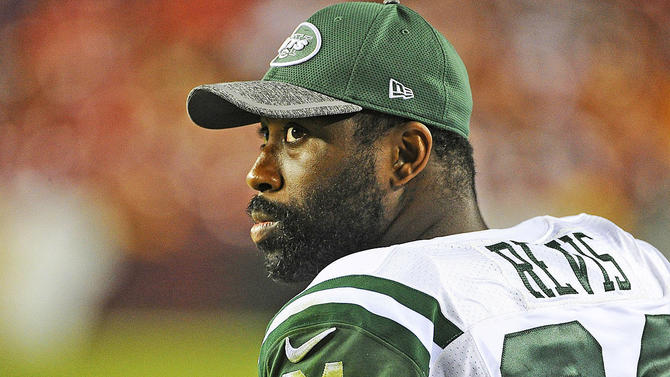
Parting ways with Revis may become more appealing. There is $6 million of Revis’ $13 million 2017 base salary that is fully guaranteed. Revis is also due a $2 million roster bonus on March 10, the second day of the league year. His salary cap number is $15,333,333.
The incident has potentially jeopardized Revis’ guarantee. Most NFL contracts contain language allowing for guarantees to void with a suspension under league policies -- substance abuse, performance-enhancing drugs and personal conduct -- or for conduct detrimental to the team and other things, such as retirement or withholding services. Some contracts have a general catch-all provision where a player engaging in conduct that adversely affects or reflects poorly on the team voids a guarantee. Revis has this type of language in his contract.
The Jets trying to invalidate Revis’ guarantee would surely result in the NFLPA filing a grievance on his behalf. Cutting the 31-year-old corner before his roster bonus is due without trying to escape the guarantee would leave the Jets with a $7 million cap charge for him where $8,333,333 of cap room would be gained.
Other older veterans could also be salary cap casualties. Releasing inside linebacker David Harris, wide receiver Brandon Marshall and center Nick Mangold would create $7.5 million, $9.075 million and $6.5 million of cap space.
A change in scenery may be best for 2013 NFL Defensive Rookie of the Year Sheldon Richardson since the Jets have one too many quality 3-4 defensive ends. The Jets shopped the talented-but-troubled Richardson before last season’s trading deadline. The first-round pick the Jets reportedly were seeking for Richardson is probably out of the question because of a subpar 2016 season and his well-documented off-field issues. Moving Richardson would wipe his $8.069 million fifth-year option salary from the books.
2. Kansas City Chiefs
Salary cap room projection: $1.757 Million
Team needs: ILB, WR, DL, CB
Key unrestricted free agents: S Eric Berry, NT Dontari Poe
Potential restricted free agent tenders: K Cairo Santos, S Daniel Sorenson, WR Albert Wilson, all at $1.808 million
The Chiefs are a legitimate Super Bowl contender, and that championship window may drive offseason decisions. Safety Eric Berry is the free agent the Chiefs can least afford to lose. He wants to remain in Kansas City but recently stated he isn’t going to play under a franchise tag again. Berry sat out most of last preseason before finally signing his franchise tender in late August. A second franchise tag for Berry will be $12,967,200, which is 120 percent of his $10.806 million 2016 franchise tender.
The expectation was that the five-year, $51.25 million extension that Harrison Smith signed with the Vikings last June would pave the way for a deal with Berry. Tyrann Mathieu’s subsequent five-year extension with the Cardinals averaging $12.5 million per year will be a hurdle to signing Berry long-term. Berry’s camp will view Mathieu’s contract as the new benchmark for safeties over Smith’s instead as a hybrid defensive back deal. Being the lone safety to earn first-team All-Pro honors in each of the last two seasons only helps Berry’s cause.
Nose tackle Dontari Poe could price himself out of Kansas City. He might be the most coveted interior defensive lineman to hit the open market. The expectation is the Panthers will franchise Kawann Short. Poe not only clogs the middle of the defense but also demonstrated some pass rush ability prior to being plagued by back issues. He may look for a contract comparable to the six-year, $85.5 million contract (worth a maximum of $90 million through salary escalators) containing $42 million in guarantees that the Jaguars gave Malik Jackson in free agency last offseason.
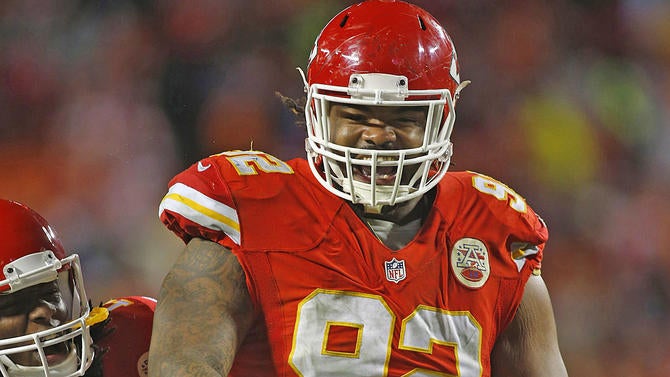
Inside linebacker is probably going to be addressed. Dont’a Hightower will be the best free agent available if the Patriots don’t put a franchise tag on him for close to $15 million. He is going to be in the high-rent district. The four-year deal averaging $12.5 million per year ($26.4 million fully guaranteed) that former teammate Jamie Collins recently signed to remain with the Browns after a midseason trade will be an important salary data point for Hightower.
The Bills’ Zach Brown and the Cardinals’ Kevin Minter will be more affordable. They may view their salary floor as the $8 million per-year average of the unrestricted free agent years that Brandon Marshall gave up last June when he signed a five-year deal with the Broncos as a restricted free agent.
The Chiefs can’t to do anything without creating cap room. Backup quarterback Nick Foles is the easiest source. The Chiefs can gain $6.75 million of cap space by passing on Foles’ option year. The emergence of Spencer Ware and persistent knee problems should make Jamaal Charles expendable, and cutting him would create $6,187,500 of cap room.
Andy Reid recently reiterating his confidence in Alex Smith hasn’t stopped speculation that he’ll be out of a job because of Tony Romo. Should the Chiefs change plans, $9.7 million of cap room will be gained by walking away from Smith’s $16.9 million cap number and next season’s unguaranteed $13.3 million salary. A short-term Romo deal could be easily structured with a 2017 cap number significantly less than Smith’s cap savings.
3. Dallas Cowboys
Salary cap room projection: $4.51 Million
Team needs: Pass rusher, CB, WR
Key unrestricted free agents: CB Brandon Carr, CB Morris Claiborne, S Barry Church, OG Ronald Leary, WR Terrence Williams
Potential restricted free agent tenders: None
The Cowboys had a $12.8 million cap overage before engaging in an annual restructuring of contracts to free up cap space, which pushes cap obligations into the future. According to ESPN.com’s Todd Archer, $17.32 million of cap room was freed up Monday with adjustments to the contracts of offensive tackle Tyron Smith and center Travis Frederick. Smith’s cap number goes from $15.8 million to $8.82 million while Frederick’s drops from and $14.871 million to $4.531 million. This means Smith converted $8.725 million of his $10 million base salary to signing bonus while $12.925 million of Frederick’s $14.221 million base salary is now bonus money. It’s the third straight year Smith has restructured his contract for cap purposes.
Other restructurings could be on the way. Dez Bryant has the biggest 2017 cap hit for a wide receiver at $17 million. The Cowboys could pick up slightly more than $8 million of cap room from a Bryant salary conversion where $12.1 million of his $13 million base salary becomes signing bonus.
Determining how best to move on from longtime starting quarterback Tony Romo is a pressing matter. Romo would prefer for Dallas to release him so he would be free to choose his next destination instead of trading him. The Cowboys might not be able to get more than a mid-round draft pick for Romo, who turns 37 in April, anyway, given his age and his injury history.

The Cowboys will have a $19.6 million cap charge for Romo relating to the bonus proration in his 2013 extension and subsequent contract restructurings for cap purposes in 2014 and 2015 if he is released or traded prior to June 2. A total of $5.1 million of cap room would be gained immediately.
The cap hit would be taken over 2017 and 2018 with either one of these transactions occurring after June 1 or releasing Romo with a post-June 1 designation. Dallas would have $10.7 million of dead money in 2017, which would free up $14 million of cap space. Romo would remain on the Cowboys’ books in 2018 with an $8.9 million cap charge.
The secondary surprisingly was a strength of the defense in 2016. The defensive backfield could have a much different look next season because retaining Brandon Carr, Morris Claiborne and Barry Church could be difficult.
Ronald Leary isn’t expected back because of La’el Collins, who missed most of the season with a right toe injury, is set to return. Right guard Zack Martin should receive a contract extension before the 2017 season that should set a new salary standard for guards. Any deal Martin signs will need to be salary cap neutral in the first year with a huge spike in salary in the second year like Frederick’s.
Finding a pass rusher either in free agency or the draft is a top priority. Randy Gregory has been a disappointment. The 2015 second-round pick struggled as a rookie. Most of last season was lost because of repeated violations of the NFL’s substance abuse policy. Gregory was recently hit with another suspension under this policy, which will prevent him from playing for at least a year.
Pass rushers are paid a premium on the open market. Olivier Vernon’s five-year, $85 million contract with the Giants containing $52.5 million in guarantees is going to be a target for good free-agent pass rushers. Chargers outside linebacker Melvin Ingram, Giants defensive end Jason Pierre-Paul and Packers outside linebacker Nick Perry have expiring contracts. Paying significant money to a free agent pass rusher will be virtually impossible unless the contract is structured like Carr’s was when he signed as a free agent. Carr had a very low cap number in 2012, which jumped significantly in other years of the contract.











